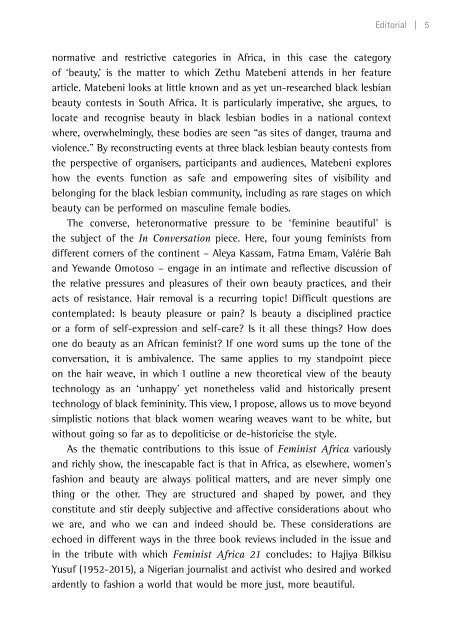The politics of fashion and beauty in Africa
fa21_proof_3
fa21_proof_3
You also want an ePaper? Increase the reach of your titles
YUMPU automatically turns print PDFs into web optimized ePapers that Google loves.
normative <strong>and</strong> restrictive categories <strong>in</strong> <strong>Africa</strong>, <strong>in</strong> this case the category<br />
<strong>of</strong> ‘<strong>beauty</strong>,’ is the matter to which Zethu Matebeni attends <strong>in</strong> her feature<br />
article. Matebeni looks at little known <strong>and</strong> as yet un-researched black lesbian<br />
<strong>beauty</strong> contests <strong>in</strong> South <strong>Africa</strong>. It is particularly imperative, she argues, to<br />
locate <strong>and</strong> recognise <strong>beauty</strong> <strong>in</strong> black lesbian bodies <strong>in</strong> a national context<br />
where, overwhelm<strong>in</strong>gly, these bodies are seen “as sites <strong>of</strong> danger, trauma <strong>and</strong><br />
violence.” By reconstruct<strong>in</strong>g events at three black lesbian <strong>beauty</strong> contests from<br />
the perspective <strong>of</strong> organisers, participants <strong>and</strong> audiences, Matebeni explores<br />
how the events function as safe <strong>and</strong> empower<strong>in</strong>g sites <strong>of</strong> visibility <strong>and</strong><br />
belong<strong>in</strong>g for the black lesbian community, <strong>in</strong>clud<strong>in</strong>g as rare stages on which<br />
<strong>beauty</strong> can be performed on mascul<strong>in</strong>e female bodies.<br />
<strong>The</strong> converse, heteronormative pressure to be ‘fem<strong>in</strong><strong>in</strong>e beautiful’ is<br />
the subject <strong>of</strong> the In Conversation piece. Here, four young fem<strong>in</strong>ists from<br />
different corners <strong>of</strong> the cont<strong>in</strong>ent – Aleya Kassam, Fatma Emam, Valérie Bah<br />
<strong>and</strong> Yew<strong>and</strong>e Omotoso – engage <strong>in</strong> an <strong>in</strong>timate <strong>and</strong> reflective discussion <strong>of</strong><br />
the relative pressures <strong>and</strong> pleasures <strong>of</strong> their own <strong>beauty</strong> practices, <strong>and</strong> their<br />
acts <strong>of</strong> resistance. Hair removal is a recurr<strong>in</strong>g topic! Difficult questions are<br />
contemplated: Is <strong>beauty</strong> pleasure or pa<strong>in</strong>? Is <strong>beauty</strong> a discipl<strong>in</strong>ed practice<br />
or a form <strong>of</strong> self-expression <strong>and</strong> self-care? Is it all these th<strong>in</strong>gs? How does<br />
one do <strong>beauty</strong> as an <strong>Africa</strong>n fem<strong>in</strong>ist? If one word sums up the tone <strong>of</strong> the<br />
conversation, it is ambivalence. <strong>The</strong> same applies to my st<strong>and</strong>po<strong>in</strong>t piece<br />
on the hair weave, <strong>in</strong> which I outl<strong>in</strong>e a new theoretical view <strong>of</strong> the <strong>beauty</strong><br />
technology as an ‘unhappy’ yet nonetheless valid <strong>and</strong> historically present<br />
technology <strong>of</strong> black fem<strong>in</strong><strong>in</strong>ity. This view, I propose, allows us to move beyond<br />
simplistic notions that black women wear<strong>in</strong>g weaves want to be white, but<br />
without go<strong>in</strong>g so far as to depoliticise or de-historicise the style.<br />
As the thematic contributions to this issue <strong>of</strong> Fem<strong>in</strong>ist <strong>Africa</strong> variously<br />
<strong>and</strong> richly show, the <strong>in</strong>escapable fact is that <strong>in</strong> <strong>Africa</strong>, as elsewhere, women’s<br />
<strong>fashion</strong> <strong>and</strong> <strong>beauty</strong> are always political matters, <strong>and</strong> are never simply one<br />
th<strong>in</strong>g or the other. <strong>The</strong>y are structured <strong>and</strong> shaped by power, <strong>and</strong> they<br />
constitute <strong>and</strong> stir deeply subjective <strong>and</strong> affective considerations about who<br />
we are, <strong>and</strong> who we can <strong>and</strong> <strong>in</strong>deed should be. <strong>The</strong>se considerations are<br />
echoed <strong>in</strong> different ways <strong>in</strong> the three book reviews <strong>in</strong>cluded <strong>in</strong> the issue <strong>and</strong><br />
<strong>in</strong> the tribute with which Fem<strong>in</strong>ist <strong>Africa</strong> 21 concludes: to Hajiya Bilkisu<br />
Yusuf (1952-2015), a Nigerian journalist <strong>and</strong> activist who desired <strong>and</strong> worked<br />
ardently to <strong>fashion</strong> a world that would be more just, more beautiful.<br />
Editorial | 5



